Trump Visit: Ahmedabad Slum Dwellers Watch as Huts Razed for ‘Beautification’
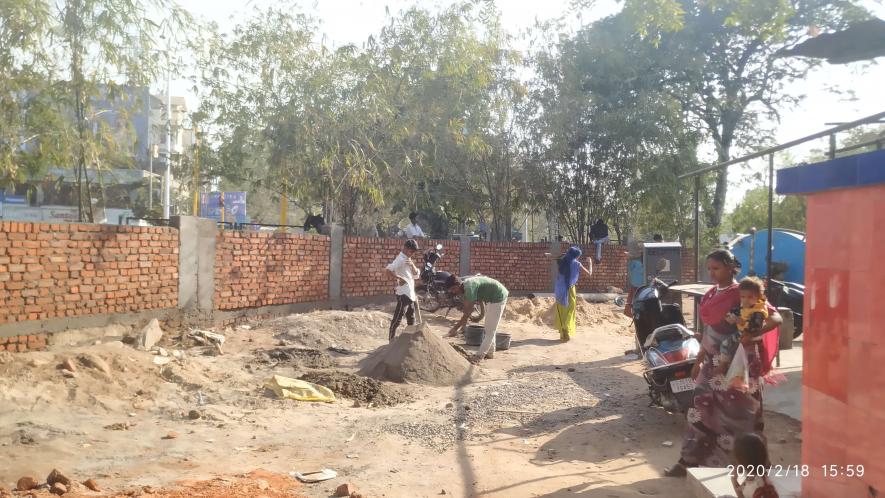
Wall Being Built
En route Sardar Vallabhbhai Patel Airport, Ahmedabad, below Indira bridge, lies Saranyavaas—about 70-year-old slum that is home to more than 2,000 people who belong to Saranya community. Traditionally, the community has been associated with the work of sharpening knives.
A wall, about 4 feet tall, encircles the slum so that it cannot be seen from the road. Two men with a truckload of potted plants are at work around the wall, busy placing the tall plants around the wall so that the wall is not visible either from the road.
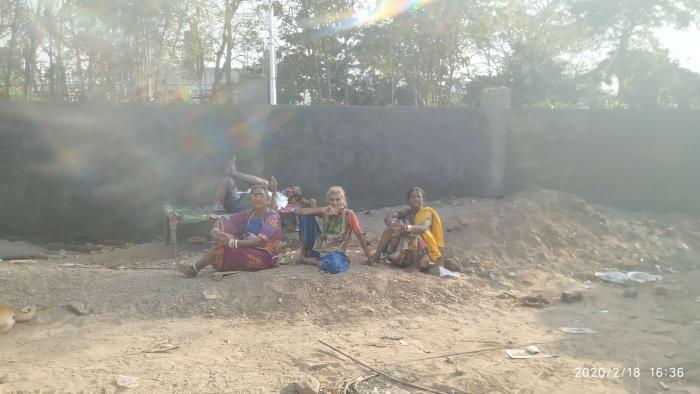
Members of a family sitting at a spot where there house stood a week back before being demolished.
This is part of the over Rs 100-crore ‘beautification’ process that the Gujarat government has undertaken for the three-hour visit of American President Donald Trump.
However, residents of Saranyavaas are used to this process of ‘beautification’. Every time a dignitary visits Ahmedabad or there is a VVIP summit or conference, Ahmedabad Municipal Corporation (AMC) takes measures to hide the slum and makes sure that the residents of the slum stay confined inside the slum till the event is over.
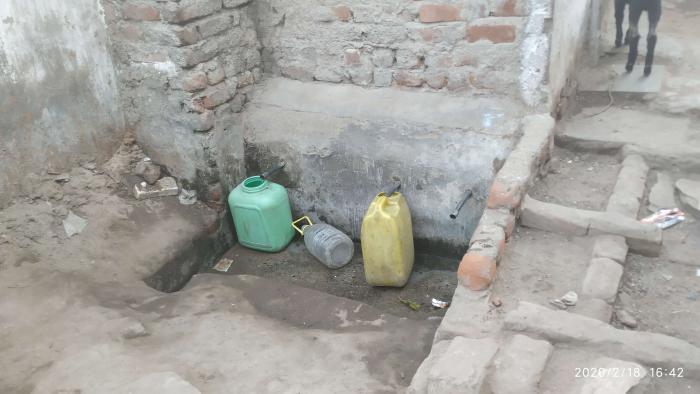
Slum dwellers placed their water containers in anticipation of water.
When Japanese Prime Minister Shinzo Abe visited Ahmedabad in September 2017 and Chinese President Xi Jingping visited in 2014 or during Vibrant Gujarat Global summit in 2019, tarpaulin clothes were used to veil the slum.
“At least three or four times a year, ahead of every VVIP visit or a big-scale event, Gujarat government covers us so that the slum is not visible to the people outside it. Usually, they use tarpaulin sheet and once the event is over, they take it down. This is first time a wall is being erected around us,” Anilbhai Saranya, a resident of the slum told NewsClick.
“To build the wall, they (AMC) have demolished all the huts that were towards the road. Nobody gave any notice to us,” added Anilbhai who owns a shop inside the slum that has been partially demolished.
“Some of the slum dwellers were given an eviction notice. But what about us whose homes they demolished without even giving any notice? They did not even announce before razing down about 20 homes with JCB,” said Rameshbhai whose one-room hut that he built for his newly wed son was demolished.
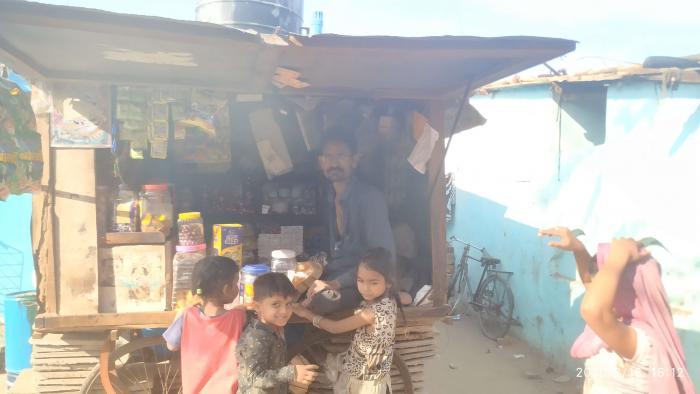
Ramesh bhai Samanya
“We have a one-room house where I live with my husband, my son and daughter-in-law. When my daughter separated from her husband and came to live with us, we loaned money from a loan shark to build her a one-room hut. Around a week back, they (AMC) came at around 9 am, when most of the men and women were out for work, and demolished all the huts that stood by the road and began erecting the wall there,” says Kesriben Balabhai Saranya.
“My daughter who is recovering from a spine surgery had gone to visit the doctor leaving her 10-year-old son behind in the hut. They suddenly started razing one hut after the other without even announcing that they are beginning the demolition. The kid ran out of the house just in time before it was razed down. None of us got a chance to save our belongings. Later, after they left, we gathered broken pieces of our homes and belongings. This is the second time in two years that my house was demolished. Earlier, during the preparation for Vibrant Gujarat Summit, they demolished it without any notice or announcement,” adds Kesriben who has been living in Saranyavaas for three generations now.
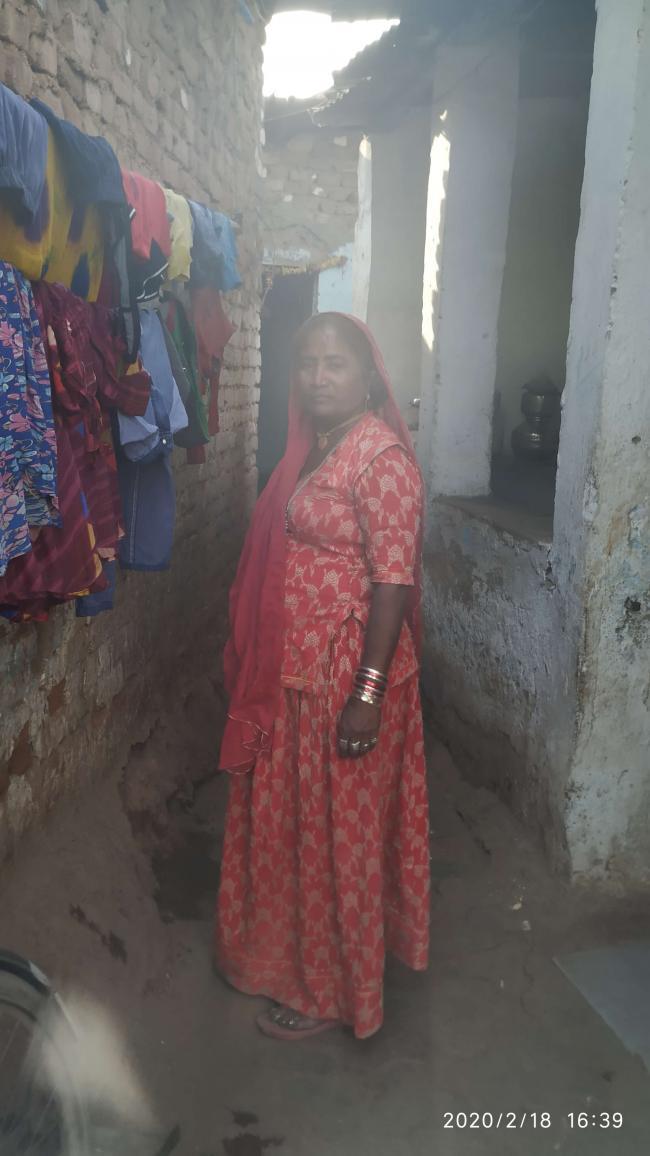
Kesriben standing 8n one of the narrow lanes leading to her hut in the slum
“I will not leave Saranyavaas till I am alive. I was born here, my children were born and grew up here. My family migrated about 90 years ago from Rajasthan and was given a piece of land to build home by the Indira Gandhi government,” 50-year-old Ashokbhai Shantilal Saranya who has got an eviction notice, told NewsClick.
“The wall is least of my problems. I am worried about not being able to go out and earn during the VVIP visit. Every time, there is an event or VVIP visit, the residents of the slum are not allowed to step outside, no matter what. Police personnel stand guard at the two entrances to the slum making sure we are confined to the slum till the event is over,” said Bemabhai, who earns about Rs 200 a day by sharpening knives.
“Most of the men are daily wage earners who take up any odd labour job to earn at least Rs 200 a day. Women of the slum work mostly work as domestic helps in areas near Saranyavaas. Our daily income hardly sustains a family. If we don’t earn for a day or two, we almost have nothing to eat,” added Bemabhai.
“Most of the families here have loans on them as the income is not enough to fulfil all the needs. Most of us have taken loans from loan sharks when we have to build a hut. Every time they demolish our homes, we are forced to taken loan again. My family owes a debt of about Rs 50,000,” added wife of Bemabhai.
Notably, the Gujarat government has not taken any steps to rehabilitate the residents or provide them with basic amenities in over 70 years that the slum has existed.
Saranyavaas does not have a drainage system leading to water logging and overflowing of open drain that flows through the slum. Lanes between the houses are narrow and difficult for even a two-wheeler to navigate. During any medical crisis, families carry people on their back or shoulders till the main road to then take them to the nearest hospital that is about 10 kilometres away.
Almost all the houses of the slum are one-room huts with an open area that accommodates a semi-covered bathing area meant for women and a cooking space. Men take bath at the Sabarmati river that flows behind the slum.
“Water scarcity is one of the primary problems here. We get water three times a day for about half an hour each time,” said a resident.
LPG cylinders are a luxury that only a handful can afford. Most of the households of Saranyavaas depend on earthen chulhas where women burn tree branches as fuel. A toilet at home is a luxury too. Most of the men defecate in open by the Sabarmati river. Handful of families that have toilets share those with the women of the slum.
The residents of Saranyavaas have Aadhaar cards and voter identification cards, but have never made any representation to the government regarding their issue.
“Most of us are uneducated, we don’t even know whom to meet,” said Ashokbhai.
“Children of the slum go to a primary school at Hansol where they study till class 8 but they discontinue after that. We cannot afford education for our kids,” he added
“How is it that this government only wants to hide us and not help us?” asked Kesriben.
“We feel like we are misfits and eyesores,” she added.
Get the latest reports & analysis with people's perspective on Protests, movements & deep analytical videos, discussions of the current affairs in your Telegram app. Subscribe to NewsClick's Telegram channel & get Real-Time updates on stories, as they get published on our website.























